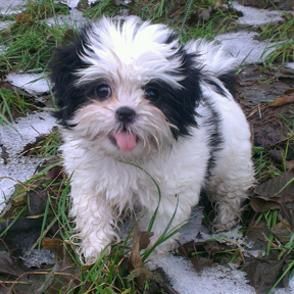A lapdog that’s perfect for both apartment living and pet-friendly hotels, the Russian Bolonka is a great breed for dogs who will serve as travel companions. Whether you travel for business or pleasure, don’t overlook the promise of the underrated breed. Also known by its full name, the Russian Tsvetnaya Bolonka literally means “colored lapdog.” Have a favorite color for dogs? Black, brown, red, or gray are all standard colors for this breed.

…HAVE EVERYTHING?
Size and Travel Options
Standing 9-10 inches tall and weighing 4.5-11 pounds, the Russian Bolonka should be able to easily qualify for traveling in the cabin of a plane. Despite their long coat, they shed only minimally and are considered hypoallergenic. Because they’re ready to serve as dutiful watchdogs, they may need training and acclimation to minimize barking fits. Even still, their size and generally sweet temperament make them a viable travel companion for planes, trains, automobiles, and other pet-friendly transportation.
Personality as a Travel Companion
The Russian Bolonka can make for a great travel companion, but they do require early training to help shape their behavior. Their independence helps minimize separation anxiety, but it’s important to socialize them early on so they get used to being around new people and develop their easy-going side. They typically do fine around children and other animals, but supervision is still recommended. They can be very sweet and loving.
Known as the quintessential lapdog, Bolonki are well-suited to keep you company during lonely nights in hotel rooms while traveling for work. Smart and agile, they’re also great at performing tricks and playtime in general. These dogs will provide plenty of entertainment for you and your family. This playtime and training can also serve as most of the exercise they need, but they’ll also benefit from the occasional walk.
Many Bolonka owners will get their pet periodically trimmed and groomed. If you let their hair grow long, you’ll need to follow a regular brushing and washing routine to keep this low-shedding animal looking its best. This can be bonding time you’re your pet at the end of the day, or groomers and doggy daycare are also a great way to keep your dog entertained while you’re in business meetings.
Health and Longevity
Like many toy breeds, the Russian Bolonka may have health troubles with patellar luxation and health conditions. There are also a number rare genetic conditions that can be screened for. Their long hair also adds to the potential for eye and ear conditions. Periodically check for signs of injury or irritation. Nevertheless, these dogs are generally healthy and routine health check-ups are only a precaution for most adult dogs. They enjoy a long life expectancy of 12-16 years.
Russian Bolonka Breeders and Adoption Centers
One of the few Russian toy breeds to survive through the early 20th Century when toy breeds were heavily discourage in Stalin’s Russia, Bolonki have gradually made a comeback since the end of the Cold War. We haven’t found prices for the Russian Bolonka to be quite as high as some other breeds, but they’re comparable overall. From a rescue or adoption center, you might pay somewhere between $300-$600 to help pay for the cost of the facility and animal supplies. For a puppy of strong pedigree from a reputable breeder, you might pay as much as $3,000 or more. The average cost is more like $1,000-$1,800.